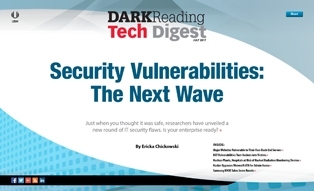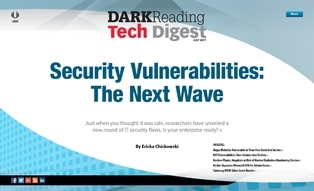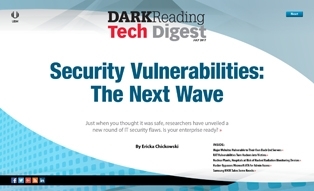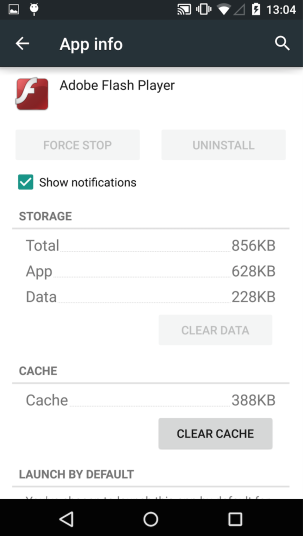Getting the Most From Your Threat Intelligence

![]()

![]()










![]()


Anomali’s Director of Security Strategy Travis Farral discusses how security pros can better use the threat intel feeds and tools they already have.

‘);
}
‘);
}

}
 Live Events
Live Events

 Webinars
Webinars


More UBM Tech
Live Events
![]()
Dark Reading Live EVENTS
![]()
![]()
![]()

![]() 0 Comments
0 Comments

![]() 0 Comments
0 Comments

![]() 0 Comments
0 Comments

![]() 0 Comments
0 Comments

![]() 0 Comments
0 Comments

![]() 0 Comments
0 Comments

![]() 0 Comments
0 Comments

![]() 0 Comments
0 Comments

![]() 0 Comments
0 Comments

![]() 0 Comments
0 Comments

![]() 0 Comments
0 Comments

![]() 0 Comments
0 Comments
![]()
Cartoon Contest
Write a Caption, Win a Starbucks Card! Click Here

Latest Comment: “Windows 10 Paint 3D is awesome!”
![]()
 Security Vulnerabilities: The Next WaveJust when you thought it was safe, researchers have unveiled a new round of IT security flaws. Is your enterprise ready?
Security Vulnerabilities: The Next WaveJust when you thought it was safe, researchers have unveiled a new round of IT security flaws. Is your enterprise ready?
![]()
![]()
![]() Reports
Reports
![]()
[Strategic Security Report] Assessing Cybersecurity Risk
As cyber attackers become more sophisticated and enterprise defenses become more complex, many enterprises are faced with a complicated question: what is the risk of an IT security breach? This report delivers insight on how today’s enterprises evaluate the risks they face. This report also offers a look at security professionals’ concerns about a wide variety of threats, including cloud security, mobile security, and the Internet of Things.
![]()

![]()

![]()

![]()


7 Hardware Firmware Hacks Highlighted at Black Hat 2017

![]()
Best of Black Hat: 20 Epic Talks in 20 Years

![]()
IoT Security Incidents Rampant and Costly

![]()

Bug Report
Enterprise Vulnerabilities
From DHS/US-CERT’s National Vulnerability Database
CVE-2017-0290Published: 2017-05-09
NScript in mpengine in Microsoft Malware Protection Engine with Engine Version before 1.1.13704.0, as used in Windows Defender and other products, allows remote attackers to execute arbitrary code or cause a denial of service (type confusion and application crash) via crafted JavaScript code within …
CVE-2016-10369Published: 2017-05-08
unixsocket.c in lxterminal through 0.3.0 insecurely uses /tmp for a socket file, allowing a local user to cause a denial of service (preventing terminal launch), or possibly have other impact (bypassing terminal access control).
CVE-2016-8202Published: 2017-05-08
A privilege escalation vulnerability in Brocade Fibre Channel SAN products running Brocade Fabric OS (FOS) releases earlier than v7.4.1d and v8.0.1b could allow an authenticated attacker to elevate the privileges of user accounts accessing the system via command line interface. With affected version…
CVE-2016-8209Published: 2017-05-08
Improper checks for unusual or exceptional conditions in Brocade NetIron 05.8.00 and later releases up to and including 06.1.00, when the Management Module is continuously scanned on port 22, may allow attackers to cause a denial of service (crash and reload) of the management module.
CVE-2017-0890Published: 2017-05-08
Nextcloud Server before 11.0.3 is vulnerable to an inadequate escaping leading to a XSS vulnerability in the search module. To be exploitable a user has to write or paste malicious content into the search dialogue.
googletag.display(‘div-gpt-ad-961777897907396673-15’);
 Tweet This
Tweet This
- [close this box]

Article source: https://www.darkreading.com/getting-the-most-from-your-threat-intelligence/v/d-id/1329531?_mc=rss_x_drr_edt_aud_dr_x_x-rss-simple



![[Strategic Security Report] Assessing Cybersecurity Risk](https://stewilliams.com/wp-content/plugins/rss-poster/cache/79eb9_Rapid7-Report.png)































![[Strategic Security Report] Assessing Cybersecurity Risk](https://stewilliams.com/wp-content/plugins/rss-poster/cache/eafa3_Rapid7-Report.png)



































![[Strategic Security Report] Assessing Cybersecurity Risk](https://stewilliams.com/wp-content/plugins/rss-poster/cache/0f672_Rapid7-Report.png)



































![[Strategic Security Report] Assessing Cybersecurity Risk](https://stewilliams.com/wp-content/plugins/rss-poster/cache/80f96_Rapid7-Report.png)






